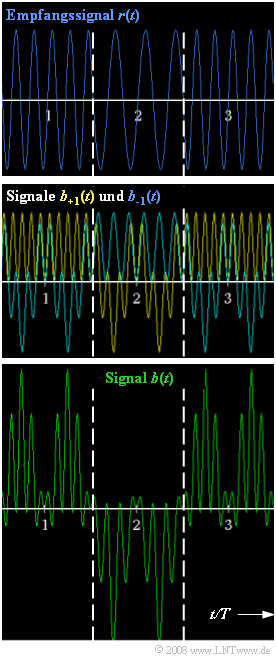Exercise 4.13: FSK Demodulation
The block diagram of the coherent FSK demodulator has already been given in the theory section, but in this exercise we will assume the lower system variant. Noise components are not considered here.
The figure on the right shows the signal waveforms at different points of the block diagram, where three symbols are drawn in each case, separated by dashed lines:
- At the top, the received signal $r(t)$ is shown, which is identical to the FSK transmitted signal. The higher frequency $f_{+1}$ belongs to the amplitude coefficient $a_ν = +1$, while $a_ν = -1$ is represented with frequency $f_{–1}$ . With respect to the symbol centers $T$, $2T$, $3T$, ..., a sinusoidal curve is present in each case. The constant magnitude of the envelope is $s_0$.
- The middle plot shows the signals after multiplication by the respective sinusoidal signals:
- $$b_{\rm +1}(t) = r(t) \cdot 2 \cdot \sin (2 \pi \cdot f_{\rm +1} \cdot t )\hspace{0.05cm},$$
- $$ b_{\rm -1}(t) = r(t) \cdot 2 \cdot \sin (2 \pi \cdot f_{\rm -1} \cdot t ) \hspace{0.05cm}.$$
- The signal $b_{+1}(t)$ in the upper demodulator branch is shown in yellow and the signal $b_{–1}(t)$ in the lower branch is shown in blue. According to the coloring scheme, the green curve applies to both curves. Relative to $r(t)$ , the signals are lower than shown.
- The lower signal plot shows the difference signal $b(t) = b_{+1}(t) - b_{–1}(t)$. The following matched filter can also be implemented as an integrator. Thus, the (normalized) decision boundary for the $ν$–th symbol is given as follows:
- $$E_{\nu}= \frac{1}{s_0} \cdot d (\nu \cdot T + T/2) = \frac{1}{s_0 \cdot T} \cdot \int_{(\nu - 1/2) T }^{(\nu + 1/2) T }\hspace{-0.3cm} b (t )\hspace{0.1cm} {\rm d}t \hspace{0.05cm}.$$
Hints:
- This exercise belongs to the chapter Nonlinear Digital Modulation.
- Particular reference is made to the page Coherent demodulation of FSK.
- A technical hint: By enlarging the image, one can recognize the signal curves a little better.
Please accept an apology on behalf of the author: blue on a black background is not great.
The following trigonometric relation is given:
- $$2 \cdot \sin(\alpha) \cdot \sin(\beta)= \cos(\alpha - \beta)- \cos(\alpha + \beta) \hspace{0.05cm}.$$
Questions
Musterlösung
- $$a_1 \hspace{0.15cm}\underline {= +1},\hspace{0.2cm}a_2 \hspace{0.15cm}\underline {= -1},\hspace{0.2cm}a_3\hspace{0.15cm}\underline { = +1} \hspace{0.05cm}.$$
(2) Aus der Grafik erkennt man im ersten und im letzten Zeitintervall fünf Schwingungen und im zweiten Intervall drei Schwingungen:
- $$f_{\rm +1} \hspace{0.15cm}\underline {= 5 \cdot 1/T},\hspace{0.2cm}f_{\rm -1}\hspace{0.15cm}\underline { = 3 \cdot 1/T} \hspace{0.05cm}.$$
- Die Trägerfrequenz ist somit $f_{\rm T} = 4/T$ und der Frequenzhub $Δf_{\rm A} = 1/T$.
(3) In diesem Bereich gilt, wobei der erste Term das Empfangssignal $r(t)$ beschreibt und der zweite Term die im Modulator zugesetzte Schwingung:
- $$b_{\rm +1}(t) = s_0 \cdot \sin (2 \pi \cdot 5/T \cdot t )\cdot 2 \cdot \sin (2 \pi \cdot 5/T \cdot t )= s_0 \cdot \big [ 1 - \cos (2 \pi \cdot 10/T \cdot t )\big ] \hspace{0.05cm}.$$
- Richtig sind demnach die beiden letzten Lösungsvorschläge.
(4) Für das untere Signal $b_{-1}(t)$ gilt im gleichen Zeitintervall entsprechend:
- $$b_{\rm -1}(t) = s_0 \cdot \sin (2 \pi \cdot 5/T \cdot t )\cdot 2 \cdot \sin (2 \pi \cdot 3/T \cdot t )= s_0 \cdot \big [ \cos (2 \pi \cdot 2/T \cdot t ) - \cos (2 \pi \cdot 8/T \cdot t )\big ] \hspace{0.05cm}$$
- Richtig sind hier die Lösungsvorschläge 1 und 4.
(5) Für den ersten Entscheidungswert gilt mit $b(t) = b_{+1}(t) - b_{–1}(t)$:
- $$E_{1} = \frac{1}{s_0 \cdot T} \cdot \int_{T/2 }^{3T/2} b_{\rm +1} (t )\hspace{0.1cm} {\rm d}t - \frac{1}{s_0 \cdot T} \cdot \int_{T/2 }^{3T/2} b_{\rm -1} (t )\hspace{0.1cm} {\rm d}t\hspace{0.05cm}.$$
- Aus dem Ergebnis der Teilaufgabe (4) erkennt man, dass das zweite Integral Null ergibt
(Integration über Vielfache der Periodendauer von Sinusfunktionen). - Das erste Integral ist gleich $s_0 · T$. Daraus folgt für den Entscheidungswert im ersten Zeitintervall: $E_1\hspace{0.15cm}\underline { = +1}$. Ebenso ist $E_3\hspace{0.15cm}\underline { = +1}$.
- Dagegen ist bei der Berechnung von $E_2$ das erste Integral Null und das zweite hat den Wert $s_0 · T$. Somit erhält man hierfür den Wert $E_2\hspace{0.15cm}\underline { = -1}$.
